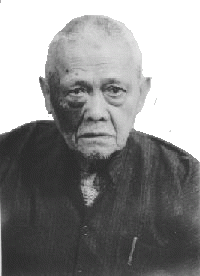
You are here
primary teacher/lineage
Student Sifus
Articles
No Articles
Products
No products
Schools
Encyclopedia
No Wiki Entries
biography (con't)
Master Pan was known in the regions around Fatshan by the nickname "Blackface Nam", due to a large birth mark on his right cheek.
From the age of thirteen until he was about 30, Pan Nam was a practitioner of Sil Lum Kung Fu. He then changed to the Wing Chun System which he practiced and taught for over fifty years.
Pan Nam's first Wing Chun instructors was Chiu Chau who learned from Chan Wah Shun's son and Yip Man's classmate, Chan Yu Mint. Pan Nam's second teacher was Lai Yip Chi, who was another of Yip Man's classmates under instructor Chan Wah Shun (in fact, Lai was Chan's live-in apprentice). When Chan became an invalid as the result of a stroke, Lai Yip Chi continued training for a time under senior classmate Lui Yu Chai, while Yip Man followed Ng Chun So. Subsequently, Lai Yip Chi apprenticed to teachers whose lineage goes back to the founder of Wing Chun on a branch of the family tree about which most practitioners are totally unfamiliar.
The Shaolin Temple monk, Yi Chum, is said by Pan Nam to be the true founder of Wing Chun. Yi Chum taught Tan Sau Ng who taught Dai Fa Min Kam, Wong Wah Bo and Leung Yee Tei (Leung Jan's teachers). "Dai Fa Min" is a nickname meaning "painted face" and refers to the makeup he wore as an actor. "Kam" is all of his true name that has survived. Painted Face Kam taught Lok Lan Koon and his nephew who taught Pan Nam's teacher Lia Yip Chi.
This branch of the Wing Chun family tree has not only preserved a different, possibly older, form of Wing Chun but has preserved the chi gung exercises that Master Pan says have been a part of the Wing Chun System from its inception.
Wing Chun involves characteristics that fit the definitions used by internal stylist to describe that which makes their systems "internal," there existed a missing "connection" with regard to history, theory, and, to a large degree, technique.
Pan Nam, while a young man, he had gone to great lengths to trace back to Painted Face Kam's version of the art, and which he has spent 50 years perfecting.
Master Pan Nam officially hung out the scrolls that proclaimed his retirement in late Spring of 1992.
Pan Nam has not been in hiding. Many well known Wing Chun instructors came from Hong Kong and the West to see Master Pan in Fatshan. They listened to the history and saw the art preserved by Pan Nam and would see that there exists another style of Wing Chun which has preserved a somewhat different practice and history.
The conflict between the stories of the origins of Wing Chun and between the theories and techniques of the various Wing Chun systems is not really a problem when understood and considered objectively. Though at first glance some of the differences are dramatic, each system in fact complements the other, and knowledge of the theories and techniques of the Wing Chun taught by Master Pan can only improve one's martial skills. Understanding the differences and the reasons for any changes that have occurred gives the only glimpse into the martial minds of the early masters, a type of "martial arts time machine."
Certainly, the history Pan Nam has preserved fills in many gaps and explains much.
Master Pan credits Tan Sau Ng as bringing Wing Chun to Fatshan "from the North" ("Tan Sau" is a nickname meaning "palm up," and refers to a particular technique unique to Wing Chun) and also notes that Painted Face Kam was a contemporary of Wong Wah Bo and Leung Yee Tei.
Besides being very accomplished in Chinese opera, Cheung Ng was especially proficient in martial arts. His one Tan-Sau was peerless throughout the martial arts world.
For some reason, Cheung Ng could not stay on in the capital, so he fled and took refuge in Fat Shan. This was during the reign of Yung Cheng. This man, nicknamed Tan-Sau Ng, was a character "unsurpassed in literary and military skills, and excellent in music and drama." He was especially proficient in the techniques of Siu Lam. After settling down in Fat Shan, he passed on his knowledge in traditional opera and martial arts to the Hung Suen (Red Boat) followers, and established the Hung Fa Wui Koon in Fat Shan. Today, Cantonese opera groups revere him as Jo-Si (Founding Master), and refer to him as Master Cheung.
It is highly probable that Tan Sau Ng had to flee the capitol because of his revolutionary activities. Also, note that the reference to "Siu Lam" (Sil Lum or Shaolin kung fu) and not to Wing Chun is probably because, as will be explained, the system did not receive its name until sometime after Tan Sau Ng.
As for the story of exactly who originated Wing Chun, Yi Chum the nun and her disciple Tan Sau Ng, or Ng Mui the nun and her disciple Yim Wing Chun, lets consider each version with an open mind, and then decide which makes more sense. Actually, no decision is really necessary. Whatever its origin, both histories are a part of the art's tradition, and both tell us important things about the old masters and the forces that shaped Wing Chun. The details of the history Pan Nam has preserved and of the independent corroboration of that history discovered cannot permit an out-of-hand dismissal of this information.
Perhaps the examples set will be followed by others, and further efforts can be made to trace this fascinating history so that the Wing Chun community can better know its illustrious founders and the fighting art to which they were dedicated.
Critical to the following discussion of the two systems are these facts:
Pan Nam's association with instructor Chiu Chau gives him intimate knowledge of the system of Wing Chun taught to Yip Man by Chan Wah Shun (Master Pan refers to this as "fast hands" Wing Chun)
Pan Nam's association with Lai Yip Chi gives him not only intimate knowledge of the earlier version of Wing Chun as it was practiced by the opera actors (Painted Face Kam, Wong Wah Bo, Leung Yi Tei, and Lai Fook Shun) of the Eight Harmony Union, but because of his own and Lai's knowledge of "fast hands" Wing Chun, he has a solid basis for comparing the two.
Therefore, Pan Nam has the rare qualification to authoritatively comment on the Wing Chun practiced by both branches of the family tree. In Pan Nam, this knowledge is perpetuated and a better understanding of the differences between the two histories and between the fighting theories and techniques of these two great systems of Wing Chun is now possible.





